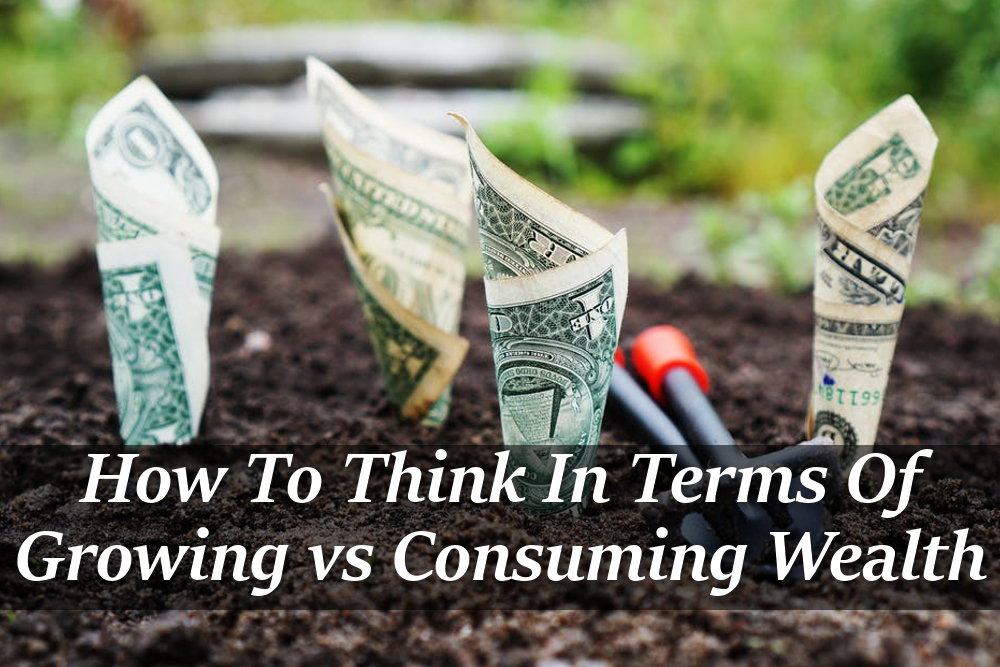In order to reach your goal of financial independence, it is important to think of your financial decisions in two primary categories, wealth growth and wealth consumption. There is nothing wrong with consuming wealth, after all, we produce wealth for the purpose of consuming/using it. However, in order to set yourself on a stable financial path, you must master a healthy habit of wealth growth and learn to measure decisions against the opportunity cost of consuming it, which we will explain more in this article.
![]() ThinkRich
ThinkRich
A ThinkRich mindset will look for opportunities to grow wealth. It will value delayed gratification and the rewards that come from it in the future by sacrificing short term wants.
![]() ThinkPoor
ThinkPoor
A ThinkPoor mindset will focus primarily on immediate desires with very little thought given toward the future.
Why Consuming Wealth is Easy
It is easy to get caught in habits of consuming wealth. The instant gratification of buying things is often more pleasurable than saving and investing. This is because of how the reward centers of our brain are activated. The anticipation of purchasing something we want triggers a release of dopamine, among many other functions, dopamine can be a feel good drug that is produced by our very own bodies. The never ending cycle many find themselves in is an endless loop of pleasure seeking and boredom. We then seek out the next “high” and the cycle continues. This is also known as the hedonic treadmill.
Our own minds are fighting against responsible choices. The path of least resistance is to give into this cycle of fleeting pleasure, and develop habits that simply look for the next dose of feel good hormones that comes from seeking pleasure, that includes the anticipation of buying shiny new things.
Opportunity Cost of Money and Time
A concept that helps to see the real cost of consumption is opportunity cost, which is the loss of future benefit by choosing a different option. In simple terms, if you were to buy a $5 latte, the opportunity cost can be measured by looking at what that $5 would grow to if you had invested it instead. If you were to put a return rate to it (assume 7% annual), each $5 latte is worth approximately $38 in 30 years.
If you purchased 1 latte a day, that would be $150 a month. Over the course of 30 years this daily habit would cost $54,000 in actual cost, but it would represent an opportunity cost of $184,063, the amount that $150 a month would grow to if you invested it instead of consuming it.
If that habit continues for 40 years, your opportunity cost grows to $396,018. For simplicity, the example ignores inflation so we can look at it in terms of today’s dollars. Otherwise these numbers get bigger because the cost of coffee (the amount spent/invested) will increase over time.
Another great example analyzing of opportunity cost of common purchases comes from the well respected value investor Warren Buffett, in a book by Alice Schroeder, she explains that as a young man Mr. Buffett calculated that he could save $300,000 in his lifetime by getting his haircut every 5 weeks instead of 4, and spending $18 for his haircut instead of $25.
These examples also illustrate the power of investing even a relatively small amount per month can add up to a massive amount of wealth over time. It is worth considering how seemingly small expenses can add up over a career, not only in real costs, but also lost opportunity to grow that wealth instead of consuming it.
Opportunity cost also applies to how you spend your time. There is nothing wrong with enjoying leisure time with friends and family, or even on your own, but you should also consider alternatives if you find yourself spending several hours every day watching TV, playing video games, or other activities that aren’t improving your health, knowledge, skills or income. Reading just 15-30 minutes a day can add up quickly over the course of a year. Consider taking on a second job or creating a side hustle if you have the time. The internet provides an amazing opportunity for self improvement and even extra income.
How to Grow Wealth
Wealth can grow in two primary ways:
- Produce and Store Value. Producing value is another way of saying “make money”. Unless you are stealing or defrauding others, you receive money for the value you produce in a system of voluntary exchange. The more value you produce, the more money people are willing to exchange for it. However, if you simply consume this value as quickly as you produce it, your wealth will not grow. It is only by spending less than you make that your wealth can grow.
- Invest Stored Value. Investing your stored (saved) value is another way to grow your wealth. Some refer to it as having your money work for you. This can be in the form of bonds, stocks, real estate, business investment, and other opportunities that allow you to grow your wealth through interest, capital gains, dividends, or other forms of cash flow, not directly by your labor, but the capital you have produced as a result of your labor.
3 Stages of Wealth Growth
- Labor: When you first start in the workforce, you probably have very little stored value. That’s OK. This means you have to primarily rely on producing value through labor and saving a portion of it in order to increase your savings (capital).
- Labor + Investment: As you move further into your career, with strong habits of budgeting, you will be able to grow wealth both by producing value as well as returns from your investments.
- Financial Independence: This is achieved when you no longer have to rely on your labor to produce for your wants and needs, but your capital is working for you. This last step is the goal we want you to achieve as quickly as possible. Developing solid wealth growth habits is the fastest way to achieve this goal.
Develop Wealth Growth Habits
Just as your brain readily releases dopamine when you buy a new car, new shoes, or whatever else might seem to call out to you, you can develop wealth growth habits that retrain to actually receive a positive boost when you make good financial decisions.
Create a Budget. This is often the first piece of advice we give. Good financial habits start with seeing exactly how much you bring in and where it all goes. Using apps like mint.com or other financial tracking applications can help you keep close tabs on your spending habits. See our page on budgeting to get help with creating a budget.
Pay Yourself First. This is part of creating a budget, but develop a habit of taking at least 10% of your gross income and put it away toward saving or investment. Stashing this away in a separate account from your ordinary accounts is a good way to keep it out of your mind.
Check In On Your Progress Regularly. It won’t take long before your balances start to accrue. After you build up an emergency fund and begin to pile up money in your long term investments, you will be motivated by your progress.
Think in Terms of Opportunity Cost. As we mentioned before, recognizing the true cost of spending money today compared to investing it and putting it into real terms is a great way to start viewing how you manage your money differently. This goes for both small daily purchases like the latte example above, but also big purchases.
Take the Long View. As you are likely aware, markets can change. Don’t let short term setbacks discourage you from adding to your investments.

